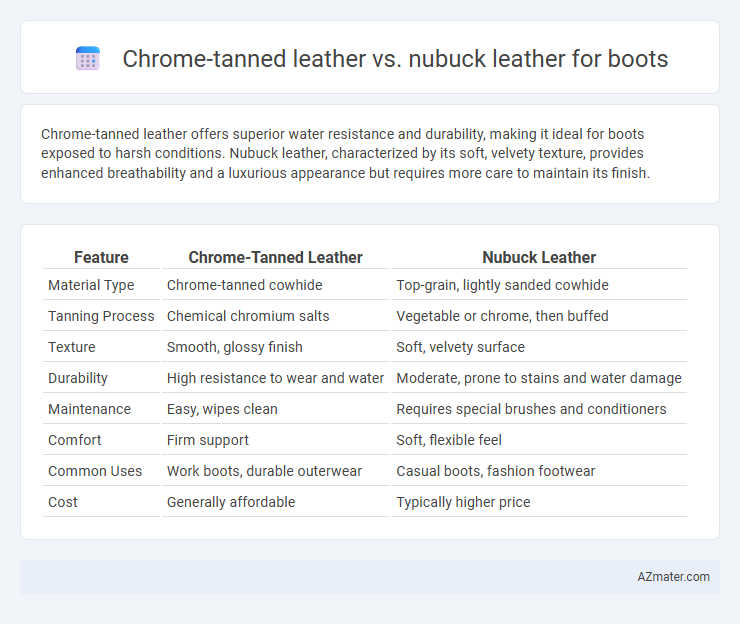Chrome-tanned leather offers superior water resistance and durability, making it ideal for boots exposed to harsh conditions. Nubuck leather, characterized by its soft, velvety texture, provides enhanced breathability and a luxurious appearance but requires more care to maintain its finish.
Table of Comparison
| Feature | Chrome-Tanned Leather | Nubuck Leather |
|---|---|---|
| Material Type | Chrome-tanned cowhide | Top-grain, lightly sanded cowhide |
| Tanning Process | Chemical chromium salts | Vegetable or chrome, then buffed |
| Texture | Smooth, glossy finish | Soft, velvety surface |
| Durability | High resistance to wear and water | Moderate, prone to stains and water damage |
| Maintenance | Easy, wipes clean | Requires special brushes and conditioners |
| Comfort | Firm support | Soft, flexible feel |
| Common Uses | Work boots, durable outerwear | Casual boots, fashion footwear |
| Cost | Generally affordable | Typically higher price |
Introduction to Boot Leather Types
Chrome-tanned leather offers exceptional durability and water resistance due to its chemical tanning process, making it ideal for rugged boots designed for heavy use. Nubuck leather, on the other hand, is a top-grain leather with a soft, velvety surface achieved through sanding, providing a luxurious appearance but requiring more care to maintain its texture and resist stains. Choosing between chrome-tanned and nubuck leather depends on the desired balance of toughness, comfort, and aesthetic appeal in boot construction.
What Is Chrome-Tanned Leather?
Chrome-tanned leather is treated with chromium salts during the tanning process, resulting in a durable, water-resistant material that maintains softness and flexibility, making it ideal for boots exposed to wet conditions. This tanning method preserves the natural grain of the leather, providing a smooth and uniform finish that resists wear and creasing over time. Compared to Nubuck leather, chrome-tanned leather offers superior strength and easier maintenance, while Nubuck's sanded surface gives a softer, velvety texture but requires more care to prevent stains and damage.
Understanding Nubuck Leather
Nubuck leather, derived from the outer side of a hide, is meticulously sanded or buffed to create a soft, velvety texture prized in high-quality boots for its luxurious appearance and durability. Unlike chrome-tanned leather, which undergoes a chemical tanning process resulting in a smoother and more water-resistant surface, nubuck requires more care to maintain its breathable and supple qualities. Understanding nubuck leather's unique grain structure and natural markings helps buyers appreciate its premium craftsmanship and the distinctive character it adds to footwear.
Leather Durability: Chrome-Tanned vs Nubuck
Chrome-tanned leather offers superior durability compared to nubuck leather due to its chemical tanning process, which enhances water resistance and maintains flexibility over time. Nubuck leather, although softer and more breathable because of its buffed grain, tends to be less resistant to scuffs, stains, and moisture, requiring more frequent care and conditioning to preserve its appearance. For boot longevity and rugged use, chrome-tanned leather is preferred due to its robust structure and enhanced protection against environmental damage.
Water Resistance Comparison
Chrome-tanned leather offers superior water resistance due to its chemical tanning process, which enhances the material's stability and prevents water absorption, making it ideal for boots exposed to wet conditions. Nubuck leather, while softer and more breathable, is less water-resistant because its surface is buffed to create a velvety texture that absorbs moisture more readily. Proper treatment with water-repellent sprays can improve the water resistance of nubuck, but it generally remains less durable against water exposure compared to chrome-tanned leather.
Comfort and Feel Underfoot
Chrome-tanned leather offers a supple and smooth texture that molds comfortably to the foot, providing a soft yet supportive feel ideal for extended wear. Nubuck leather delivers a velvety, napped surface with a plush touch, enhancing breathability and cushioning underfoot for superior comfort. Both materials contribute to foot stability but chrome-tanned leather typically provides greater moisture resistance, while nubuck excels in softness and natural grip.
Aesthetics and Finish Differences
Chrome-tanned leather features a smooth, glossy finish with vibrant color retention, offering a polished and sleek appearance ideal for formal boots. Nubuck leather, made from top-grain cattle hide buffed on the outer side, presents a velvety, matte texture with a soft, suede-like surface that develops a rich patina over time. The aesthetic contrast lies in chrome-tanned leather's shiny, uniform finish versus nubuck's natural, slightly roughened look, influencing boot style from refined elegance to casual ruggedness.
Maintenance and Care Requirements
Chrome-tanned leather boots require regular cleaning with a damp cloth and conditioning to maintain suppleness and prevent cracking, benefiting from water-resistant finishes that enhance durability. Nubuck leather demands gentle brushing with a nubuck brush to remove dirt and avoid water exposure, as it is more susceptible to staining and requires specialized nubuck cleaners for effective maintenance. Both types benefit from protective sprays, but nubuck's buffed surface necessitates more frequent care to preserve texture and appearance.
Price and Value Considerations
Chrome-tanned leather boots typically offer a lower price point due to faster processing and mass production efficiency, making them accessible for budget-conscious buyers. Nubuck leather boots carry a higher price but provide superior softness and a premium feel, justifying the cost for those seeking luxury and durability. Value considerations depend on long-term wear and aesthetic preferences, with chrome-tanned offering practicality and nubuck delivering enhanced texture and style.
Choosing the Right Leather for Your Boots
Chrome-tanned leather offers durability, water resistance, and a smooth finish, making it ideal for rugged boots used in harsh conditions. Nubuck leather, characterized by its soft, velvety texture and breathability, provides enhanced comfort and a stylish appearance but requires more maintenance to prevent stains. Selecting between chrome-tanned and nubuck leather depends on balancing durability needs with aesthetic preferences and upkeep commitment for your boots.

Infographic: Chrome-tanned leather vs Nubuck leather for Boot
 azmater.com
azmater.com